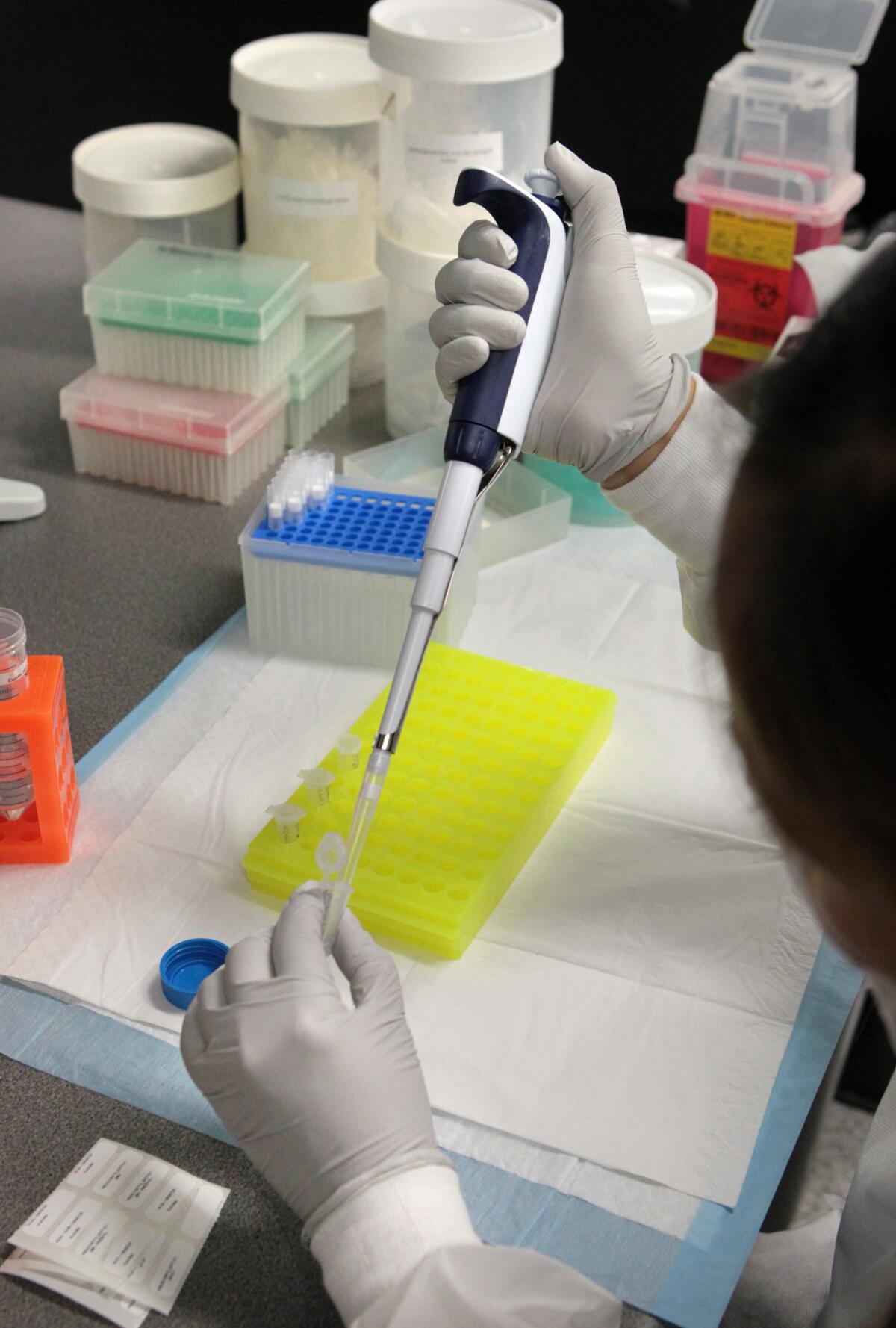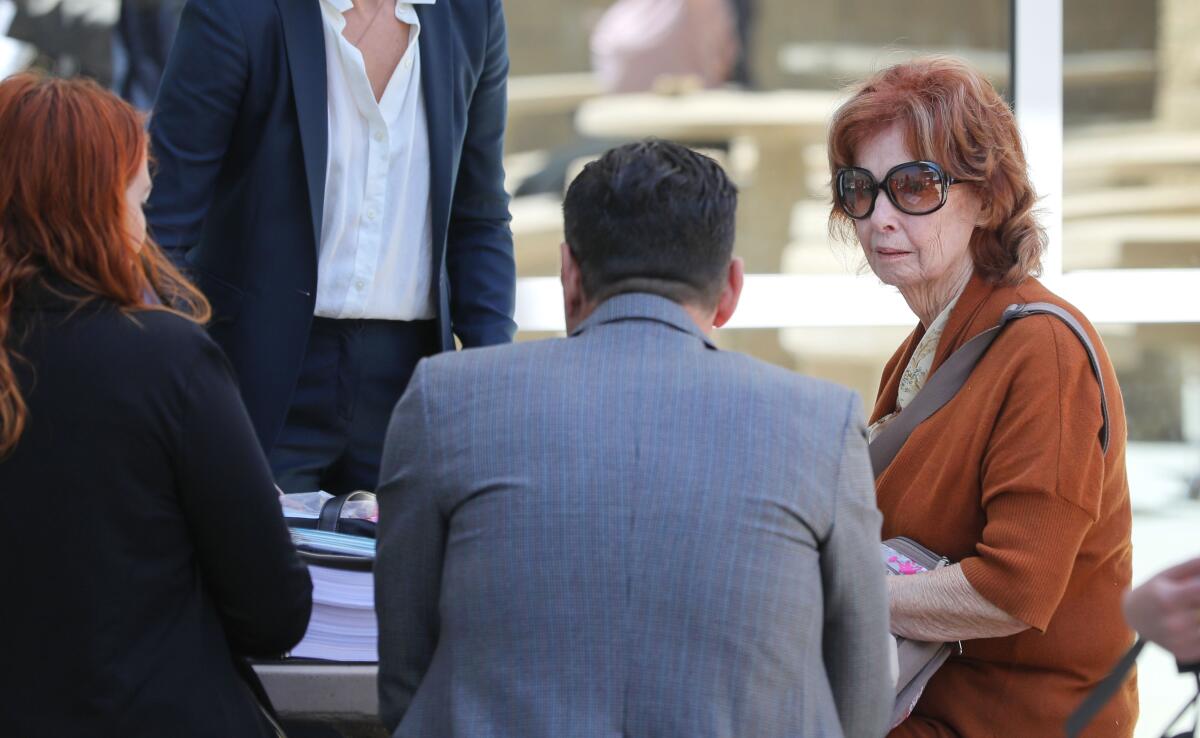Problems in San Diego crime lab come to light in audits and internal documents

SAN DIEGO — In 2018, a team from the U.S. Justice Department arrived in San Diego for an audit of the San Diego Regional Crime Laboratory to determine whether the lab was meeting FBI standards, allowing it to be part of the national DNA database system.
The results were not great. Auditors found that security at the lab didn’t meet FBI standards. The reason: Keycards, electronic passes that allow employees access to the lab and certain spaces within it, were not being kept track of.
Auditors found that a master list intended to track which employees had keycards was outdated and unreliable. Internal records showed half a dozen former employees and private contractors who had worked at the lab still had active keycards, even though they had long ago stopped working there — in one case a card remained active 14 years after its last use. In others, the time period ranged from as low as eight years to a dozen years.
Moreover, lab officials could not be sure that they had collected the keycards. The implications of such a security lapse were potentially huge, the report concluded.
“This created a heightened risk of improper access to privacy information and evidence by unauthorized individuals, as well as compromising the chain of custody of the evidence,” auditors wrote. “In addition, the security of the laboratory was put at risk.”
Embarrassed lab officials did not contest the findings. They noted that there was no evidence the cards had been used over the years. And they said things would be different in a few months when the lab moved to a new, $107-million five-story headquarters at the county’s Clairemont Mesa campus.
New building, new keycards and, they said, a new policy would be in place by August 2018.
Testimony at the Jane Dorotik hearing has revealed long-running concerns inside the county crime lab about the work record of a former criminalist
But it was not until nearly 18 months later, in June 2020, that federal auditors formally closed the audit. That’s because it took the lab months to provide documentation to satisfy auditors that they had fixed the issue.
In an email response to questions about the audits, the San Diego County Sheriff’s Department said the delay was because it was not aware until December 2019 that more information was needed. Now, the statement said, the lab does security audits each quarter.
The keycard problem was one of several that surfaced in a review of years of audits and internal reports of the county lab conducted by the San Diego Union-Tribune.
Overall, the years of audits generally give good marks to the lab, which processes some 15,000 cases a year for nearly three dozen local, state and federal agencies. The lab has never lost its accreditation since earning it in 2003.
But some of its work over the years has become pivotal in the ongoing case of Jane Dorotik, a former Valley Center woman who was convicted in 2001 of murdering her husband, Robert. Much of the evidence in that case relied on the lab’s work on bloodstains, crime scene reconstruction and DNA.

Last year, after a team of lawyers from the Loyola Law School Project for the Innocent had taken on an appeal in her case and raised a series of issues about the lab, the San Diego County district attorney’s office conceded that she did not get a fair trial in 2001, erasing the conviction.
Prosecutors want to put her on trial again. Since April, the two sides have been locked in a lengthy pretrial hearing. And while that hearing has focused on the Dorotik investigation and the trial time period between 2000 and 2002, defense lawyers have been able to uncover evidence about mistakes in the lab before and after that time.
Their work led prosecutors to issue two “Brady letters,” missives to the local defense bar stating that the work history of two former criminalists — Connie Milton and Charles Merritt— could affect their credibility as witnesses. The pair worked on hundreds of cases in their long careers, though the letters did not specify what cases, if any, could be affected.
Merritt retired in 2013 after 31 years in the lab. Milton retired this year after nearly 25 years.
Solid marks, red flags
The Union-Tribune reviewed more than a decade of audits and assessment reports as well as internal lab documents obtained through the Public Records Act and court records.
While audits for many years gave the lab a clean bill of health, others identified a variety of issues. Many were seemingly minor, like not having a record retention policy for audits, or not providing documents to support the conclusion made by criminalists in a case. Or citing a cockroach problem in the forensic biology section of the lab’s former building.
Others were more serious.
A 2014 audit by the American Society of Crime Laboratory Directors focused on a key part of the lab’s work — “technical reviews,” where another criminalist scrutinizes a report prepared by a colleague for a piece of evidence, such as a DNA profile.
These are a standard part of crime lab work. But the audit found “multiple instances” where those reviews “were not sufficiently thorough to detect errors in the reports” in the crime scene, fingerprint and trace evidence sections of the lab.
In its response at the time, lab officials said they would discuss the reports that contained errors with both the analysts and reviewers, issue amended reports if necessary, and hold a general meeting to go over the technical review process.
The internal documents included a review of a spate of errors involving switching samples in the DNA section of the lab — essentially confusing one piece of genetic evidence from a person with another — between 2012 and 2014.
The lab commissioned an internal review in June 2014 of five such incidents — documented in internal lab reports known as “corrective actions” — to determine whether there were any common trends or ways to reduce the number of such errors, according to the report obtained by the Union-Tribune. But the review did not turn up any such evidence.
“With the exception of attention to details, no one common cause can be determined,” wrote DNA Technical Manager Michelle Hassler.
Sample switches
The statement of the Sheriff’s Department said one of the cases reviewed was a “data input error” and another involved conducting “an additional DNA analysis step than intended.” It could not be determined whether the errors affected any cases from that time. The documents did not identify cases by name.
Suzanna Ryan, a DNA expert and forensics consultant based in Carlsbad, said sample-switch incidents were a concern. “That’s one of the most serious errors in a lab,” she said. Even though no common cause could be determined and they happened nearly a decade ago, the errors signaled a problem.
“If they caught five,” she said, “the question is, are there any occurrences they did not catch?”
Botched testing errors predated the sample switches reviewed by Hassler. In the 2011 murder trial of Marc Jernigan, court records that defense lawyer Christopher Plourd obtained had three dozen pages of lab records documenting a variety of errors in tests, many of them showing criminalists contaminating samples with their own DNA, or finding other unknown DNA profiles in the evidence.
Nearly all of the 38 reports, from four different analysts including Milton from 2004 to 2008, have a hand-written note from a lab supervisor at the he bottom reading, “No further action at this time.”
Plourd, now a Superior Court judge in Imperial County, argued at the time that the documents showed not only an issue with Milton but “an overall problem with the San Diego County Sheriff’s Department crime laboratory as evidenced by the errors that routinely have occurred in the laboratory at and around the time of the DNA testing done in this case.”
In the statement, the Sheriff’s Department said that when errors are identified, the criminalist’s work is reviewed to determine the cause of the mistake — but that a review “does not encompass all work done.”
Audits that discover problems are not unusual, Ryan said. “Any lab you look at, you are going to find errors,” she said. “Most of the time they are errors that are minor or a one-time occurrence. You try to avoid them.”
Quality control
But Brandon Garrett, director of the Wilson Center for Science and Justice at Duke University School of Law, said “labs are supposed to have quality controls in place to make sure they don’t make mistakes.”
Garrett wrote a book on faulty forensic science and scandals in crime labs that revealed botched testing, falsified test results and other errors. He said audits only go so far.
“They are not a measure of quality in the lab,” he said. Such audits generally don’t include techniques such as checking cases randomly to assess lab processes. He said labs also needed to be more transparent when errors were found.
He said if a hospital lab discovered a problem with a piece of equipment or errors by a lab worker, it would immediately compile a list of all the cases the equipment was used on or the employee worked on. “They would have a list of all patients,” he said.
But that does not always happen. When asked whether the sample-switch errors affected any cases, the Sheriff’s Department couldn’t say, and referred questions to the district attorney’s office.
Even though prosecutors notified defense lawyers about Merritt and Milton, the letters gave no specifics about which cases, or which tests, were flawed. Instead it told lawyers who believed they might have a case that was affected to contact a specific prosecutor in the office.
How many have done that is not known. A spokesman for Dist. Atty. Summer Stephan said “a few defense attorneys have reached out with questions,” but there have been no moves to reexamine cases.
More to Read
Sign up for Essential California
The most important California stories and recommendations in your inbox every morning.
You may occasionally receive promotional content from the Los Angeles Times.












